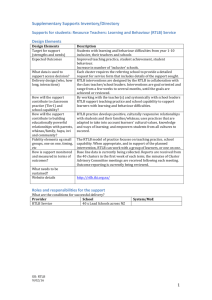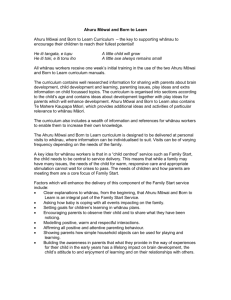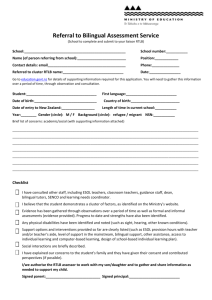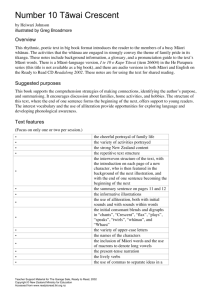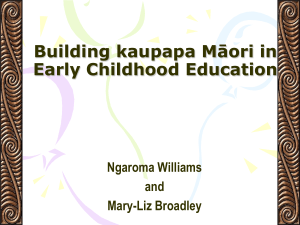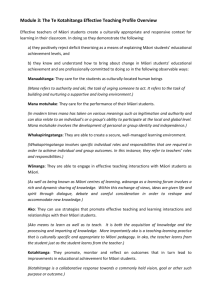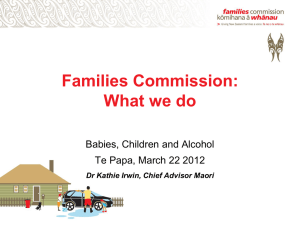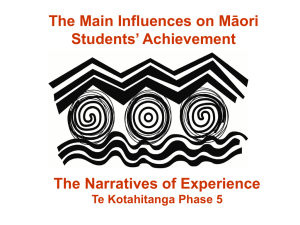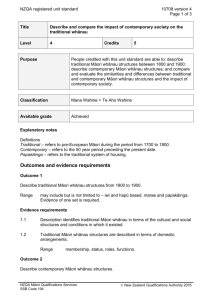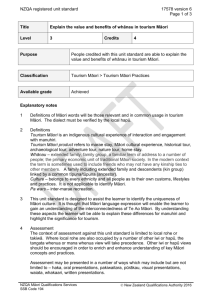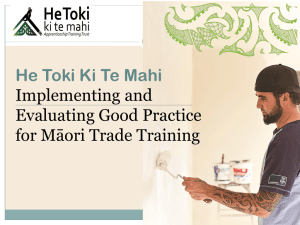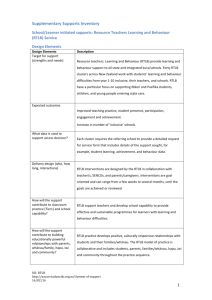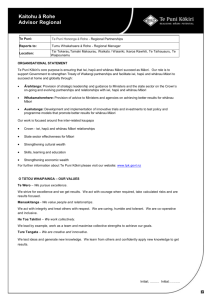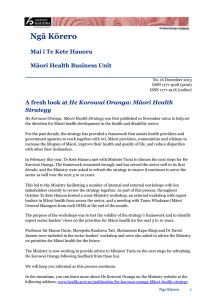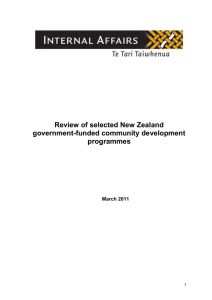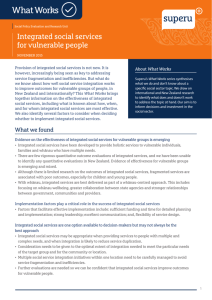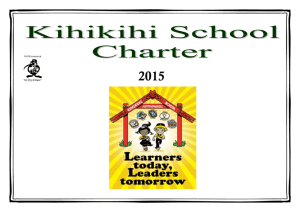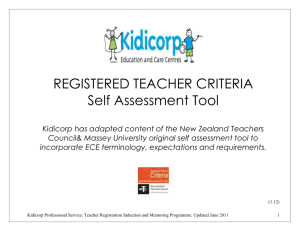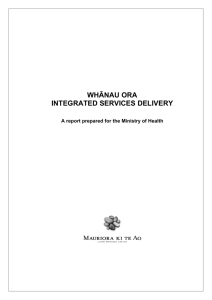RTLB Indicators aligned to the Professional Standards and
advertisement
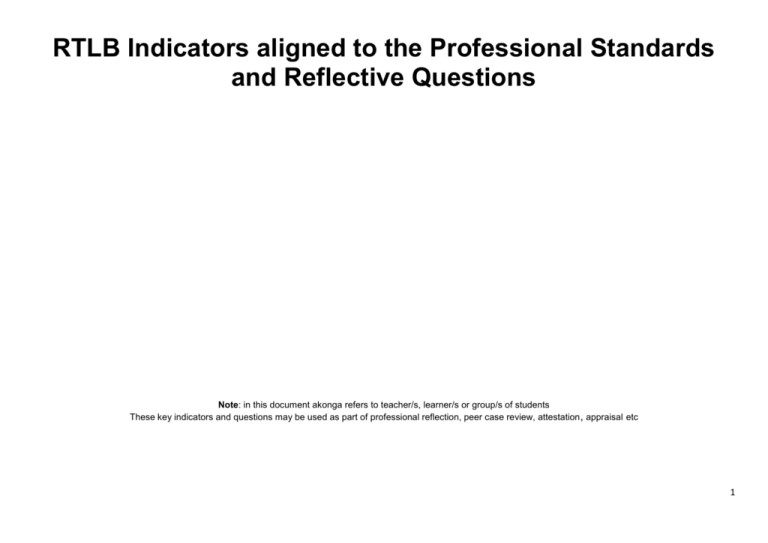
RTLB Indicators aligned to the Professional Standards and Reflective Questions Note: in this document akonga refers to teacher/s, learner/s or group/s of students These key indicators and questions may be used as part of professional reflection, peer case review, attestation , appraisal etc 1 Professional Standards Criteria Registered Teacher Criteria- Professional Relationships and Professional Values Key Indicators for RTLB Establish and maintain effective professional relationships focused on the learning and well being of akonga Demonstrate commitment to promoting the wellbeing of all akonga. Demonstrating highly effective communication skills with a range of audiences Working in a collaborative, consultative model Facilitating planning and review successfully Providing constructive feedback Interacting appropriately with Māori in a range of settings Seeking advice and guidance when needed Working toward mutual trust and guidance Focusing on problem solving Effectively managing positive relationships Reinforcing close working relationships between schools and parents, caregivers and whanau Engaging in ethical, respectful, positive and collaborative professional relationships with: akonga, other professionals, whanau and carers, community Using appropriate skills, techniques and resources across a range of interactions to model desired behaviour. Networking and liaising with other relevant agencies Working across a range of levels within the compulsory school sector Adapting programs and curriculum at a range of school levels in ways that promote inclusive practice Supporting changes to learning environment to cater for diversity at individual, class and school levels Taking all reasonable steps to promote teaching environments that are physically, socially, culturally and emotionally safe. Acknowledging and respecting the languages, heritages and cultures of all akonga Documenting interactions with akonga regularly, both formally and informally Complying with relevant regulatory and statutory requirements. Participating in processes that lead to informed changes in school management practices and positive school cultures Contributing actively to the continuing development of support systems for students at risk Reflective Questions How did I ensure the teacher’s involvement in this process? How did I ensure the family’s involvement in this process? How did I negotiate the roles of other team members including family/whānau? How acceptable and do-able are the intervention strategies? What other features of my work helped me to engage with this teacher/family/school? Explain why it is important for this akonga, to be targeting these behaviours. Describe the behaviour to be changed / managed Describe the behaviour to be promoted / taught / maintained. What does this behaviour look like/ sound like, to the observer? Describe the next learning steps Describe how this learning will be promoted / taught / maintained Briefly explain a situation involving some risk and describe why I believe it required an immediate 2 response Demonstrate commitment to bicultural partnership in Aotearoa New Zealand. Assessing risks to students' physical, cultural and emotional safety and consulting on appropriate actions Participating in Māori cultural settings and developing an understanding of iwi protocols Using interventions and strategies that reflect an awareness of the Treaty Working with Māori agencies in appropriate ways Pronouncing and using Māori names and words correctly Demonstrating respect for the languages, heritages and cultures of both parties to the Treaty of Waitangi Working to enhance positive relationships between schools and whanau Using consensus approaches to decision making Ensuring that changing social and cultural factors affecting the school communities are reflected in programmes provided How was collaboration with whānau sought? How did I determine whānau goals and aspirations for their tamariki /rangatahi /mokopuna? How have I used Mäori ways of knowing when trying to understand the situation; for example using Te Whare Tapa Wha? How did whānau perspectives and explanations inform defining the target learning and behaviours? Committing to successfully complete the required RTLB qualification Identifying ongoing professional learning needs through the appraisal process and in response to cluster needs analyses Communicating personal and professional needs to the appraiser when establishing performance expectations Identifying appropriate professional development activities Demonstrating a high level of awareness of educational developments in the areas of learning and behaviour Engaging in inquiry to support improved practice Attending appropriate seminars, courses, workshops or conferences Identifying, locating or providing appropriate resources Participating in activities that enhance the understanding of Treaty of Waitangi issues Contributing to the review, and improvement of RTLB service delivery Participating in communities of practice and peer review processes Accessing current research and making this available to teaching colleagues Participating in professional development that promotes consideration of emerging educational thinking and practices Identify any barriers to effective practice I encountered and what support I engaged to problem solve around overcoming them? What cultural support did I access to reflect on the Māori-specific aspects of my involvement? Is any follow up necessary? What needs have been highlighted in my cluster’s strategic plan and in what ways can I gain the skills and knowledge necessary to address these priorities? What aspects of my practice would be enhanced my involvement in collegial support, case-sharing or a Community of Practice? In what ways have I maintained currency with new MOE initiatives? Demonstrate commitment to ongoing professional learning and development of personal professional practice Show leadership that contributes to effective Facilitating staff development workshops and network meetings Providing in-service training for teaching and support staff Building school capability through frequent and wide ranging interactions with staff and school management How has my involvement built teacher capability? In what ways have I supported schools to cater for diverse learners? 3 teaching and learning Providing constructive evaluative feedback to teachers and schools for development purposes Working in a leadership role to promote school improvement Supporting colleagues to improve their practice through consultation and collaboration Contributing to professional debates related to RTLB practice and wider educational matters Actively contributing to professional learning communities Providing appropriate examples for teachers working with Māori students Ensuring that procedures for making decisions are consistent with national and cluster policies and procedures In what ways have I supported the professional growth of my RTLB colleagues? How have I been able to demonstrate positive outcomes for the akonga I have been involved with? Registered Teacher Criteria- Professional Knowledge in Practice Conceptualise, plan and implement an appropriate learning programme Promote a collaborative, inclusive and supportive learning environment Demonstrate in practice their knowledge and understanding of how ākonga learn Ensuring decisions are based on reliable data and best evidence Involving teachers, whanau and other stakeholders in programme planning Articulating clearly the aims of and rationale for interventions planned Supporting staff in inclusive teaching practices Modelling and promoting effective programme implementation Monitoring the implementation of strategies and programmes Reviewing and adapting programmes as required Documenting case records in a timely and appropriate way Implementing a range of inclusive evidence-based strategies Supporting teachers to build their capability in providing inclusive learning environments, by planning and modelling effective inclusive practice eg. Peer tutoring; cooperative learning; Restorative practice. Promoting strategies which engage and motivate diverse akonga Fostering trust, respect and cooperation with and among akonga Working at management level co-constructing systems level change Supporting the development and maintenance of environments which enhance learning by recognising and catering for the wellbeing and learning needs of a diversity of students Enabling akonga to make connections between their prior experiences and learning and their current learning activities Providing opportunities and support for akonga to engage with, practice and apply new learning to different contexts Can I show some data summaries, charts or graphs which evidence my assessment, hypothesis and planning? What is the relationship between the target learning and/or behaviours and the referral learning and/or behaviour issues? How does the plan attend to the ecology, antecedents and systems within the learning environment? How does this plan promote positive social networks? How does this plan foster inclusive teaching practices? What factors have supported a sense of collaboration amongst the team working together for this akonga? How have I involved others in developing a shared understanding of the situation and the way forward? Can I show a written record of the planning for an 4 Respond effectively to the diverse language and cultural experiences, and the varied strengths, interests and needs of individuals and groups of ākonga Work effectively with the bicultural context of Aotearoa New Zealand Analyse and appropriately use assessment information, which has been gathered formally and informally Providing positive, constructive, specific feedback to akonga Assisting akonga to think critically about information and ideas and to reflect on and take responsibility for their learning and behaviour Setting up opportunities for students to co-construct meaning alongside their peers as they develop key competencies Initiating and participating in the development of teaching resources, strategies and techniques Identifying implementing and evaluating a range of educational and management approaches to meet akonga and school needs. Demonstrating knowledge and understanding of social and cultural influences on learning, by working effectively in the bicultural and multicultural contexts of learning in Aotearoa New Zealand Selecting teaching approaches, resources, technologies and learning and assessment activities that are inclusive and effective for diverse akonga Modify teaching approaches to address the needs of individuals and groups of akonga Differentiating pedagogy and andragogy in response to diverse needs Supporting the implementation of Ka Hikitia and other MOE initiatives to promote successful outcomes for Māori akonga Understanding and promoting culturally responsive pedagogy Practising and developing the relevant use of te reo Māori me nga tikanga-a-iwi in context Specifically and effectively address the educational aspirations of akonga Maori, displaying high expectations for their learning Participating in Māori cultural settings and developing an understanding of Iwi protocols Using interventions and strategies that reflect an awareness of the treaty and Maori learning styles eg, Te Kotahitanga & Ka Hikitia Working with Māori whanau and agencies in an appropriate way. Collecting and documenting appropriate data for accepted referrals and basing decision making, support and advice on that data Maintaining an ecological focus when collecting data, ensuring that characteristics of the learner, the learning task and the learning environment are considered Analysing assessment information to identify and progress ongoing learning needs of akonga Using assessment information to give regular and ongoing feedback to guide and support further learning akonga and data on which this plan was based? How does this plan focus on the learning of new skills for the akonga? How has data been used to evaluate the progress made by the akonga? How do my planned interventions link to the NZ Curriculum? How do I know that the plan is being implemented in the way it was agreed to across settings? What components/ aspects were included in the intervention to strengthen cultural identity and belonging? How did my involvement acknowledge and reflect the approaches, thinking and priorities of the akonga and their family? How did I negotiate the roles of other team members including family/whānau? How did I gain family/whānau feedback on practice– what did the process ‘look’ like? How did the intervention affirm and enrich cultural identity and belonging for the mokopuna/ rangatahi / tamariki? How did the whānau engage and contribute to the process of measuring progress towards the intended outcomes? How did planning acknowledge and reflect Kaupapa Māori approaches, thinking..? What were the main methods I used in my assessment? How is this reflected in the raw data? Why did I use those particular assessment methods? How ‘appropriate’ are these tools for carrying out an ecological assessment in this context? How well does my case file reflect the work done? 5 Use critical inquiry and problem solving effectively in their professional practice Fostering involvement of whanau in the collection and use of information about the learning of akonga Providing pre-intervention and post-intervention data that demonstrates the effectiveness of teaching techniques Analysing assessment information to reflect on and evaluate the effectiveness of the RTLB involvement Communicating assessment and achievement information to relevant members of the learning community in a timely and clear way Systematically and critically engaging with evidence and professional literature to reflect on and refine practice Responding professionally to feedback from members of their learning community Critically examining their own beliefs, including cultural beliefs, and how they impact on their professional practice and the achievement of akonga Using the collaborative problem-solving model and maintaining a strengths-based approach to address the needs of referred akonga Engaging in inquiry to support improved practice Continually evaluating and reflecting on their practices and acting on areas where they can be improved How does my assessment identify the strengths of the akonga and their learning environment? What patterns have I noted that help support my analysis? How did I involve others in the formulation of my analysis? How has the data demonstrated positive outcomes for the akonga concerned? Identify any barriers to effective practice I encountered and what support I engaged to problem solve around overcoming them? How did I gain teacher feedback on practice– what did the process ‘look’ like? What have I learnt from working with this akonga that could inform my future practice? What questions do I have about my involvement with this akonga? How might these questions form the basis of an inquiry cycle? 6

